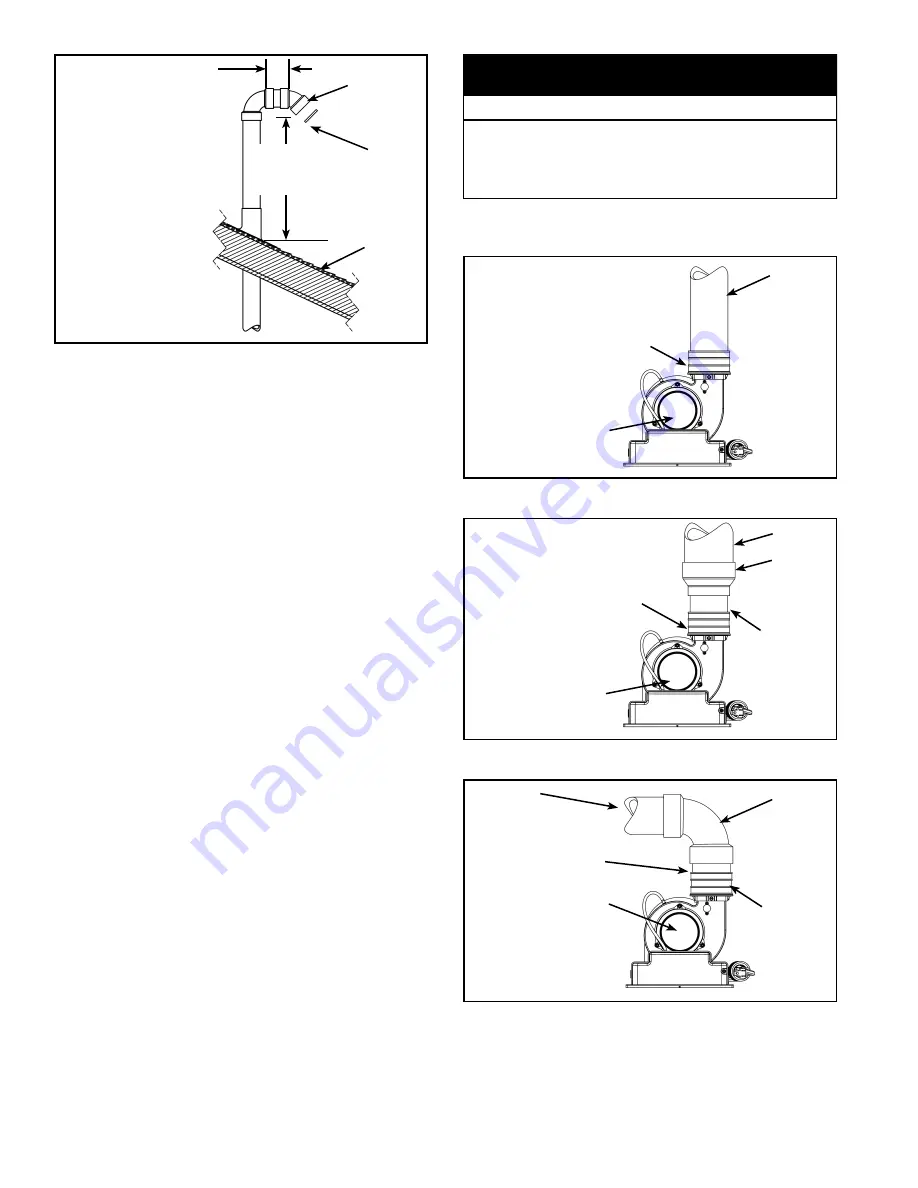
100221773_2000189439_Rev. 01
www. lochinvar .com
33
TERMINATION
MAY BE 90°
ELBOW
3 in. MIN.
LENGTH
ROOF
LINE
A VENT USED IN A
SPECIAL VENTING
SYSTEM WITH POSITIVE
VENT PRESSURE AND
PASSING THROUGH A
ROOF SHALL EXTEND AT
LEAST 18 in. ABOVE THE
HIGHEST POINT WHERE
IT PASSES THROUGH THE
ROOF SURFACE AND ANY
OTHER OBSTRUCTION
WITHIN A HORIZONTAL
DISTANCE OF 18 in. .
A VERTICAL VENTING
SYSTEM MUST BE
SUPPORTED EVERY 5 ft. .
18 in. OR
ABOVE
ANTICIPATED
SNOW LEVEL
RODENT
SCREEN
(INSTALL
INTO
ELBOW)
Figure 36.
Vent pipe connection to blower
1. The vent piping connects into the rubber coupling
located on the top of the blower assembly. This
coupling includes gear clamps to connect the venting
to the blower. These connections must be properly
seated and tightened to prevent the leakage of flue
gases into the area. See Figure 37 through Figure 39.
2. The water heater is supplied with a 3” rubber
coupling to accept the vent pipe and is required in all
installations. Do not attempt to connect the vent piping
directly to the blower without using the rubber coupling.
Note:
Polypropylene vent systems require separate
adaptor.
3. Before installing clean and lightly sand the end of the
plastic vent piping that will connect into the rubber
coupling. For polypropylene vent systems follow
manufacturer’s instructions.
4. Loosen the upper clamp on the rubber coupling and
insert the sanded end of the vent piping a full 1-1/4
in. . Do not use glue or sealant in the rubber coupling.
Check that there is no stress on the connection or the
vent piping that may be caused by twisting or bending.
5. Tighten the upper clamp so that the vent piping is
firmly secured in the coupling and is gas tight. Do not
over tighten or cause distortion of any of the parts.
Ensure the bottom of the rubber coupling is firmly
seated on the blower outlet and that the lower gear
clamp is also secure. Check to ensure there is no
distortion or movement of the clamped assembly once
it is completed.
6. If the outlet vent pipe is to be turned horizontally
directly off the blower, a 3 in. long section vent pipe
shall be used to connect the elbow to the rubber
coupling (see Figure 39). For heaters installed with
the option using the first 5 ft. being CPVC venting, the
first elbow is in addition to the 5 ft. rule (see “Venting”).
•
Do not overtighten the top and bottom gear clamps of the
rubber coupling.
•
Do not apply solvent cement or silicone to the rubber
coupling connection.
Property Damage Hazard
CAUTION
Coupling installations according to vent sizes
3” VENT
PIPE
3” RUBBER
COUPLING
(SUPPLIED)
BLOWER
* HEATERS
EQUIPPED WITH
THE 181° CONTROL
MUST USE CPVC
PIPING FOR
THE FIRST 5’ OF
VENTING.
Figure 37.
4” VENT
PIPE*
3” RUBBER
COUPLING
(SUPPLIED)
3” VENT
PIPE*, 3 in.
MAX LENGTH
3”-4”
ADAPTER*
(FIELD
SUPPLIED)
BLOWER
* HEATERS
EQUIPPED WITH
THE 181° CONTROL
MUST USE CPVC
PIPING FOR
THE FIRST 5’ OF
VENTING.
Figure 38.
3” ELBOW
**(FIELD
SUPPLIED)
3” RUBBER
COUPLING
(SUPPLIED)
BLOWER
3” VENT
PIPE*
(SUPPLIED)
3” VENT
PIPE*
(SUPPLIED)
* HEATERS
EQUIPPED WITH
THE 181° CONTROL
MUST USE CPVC
PIPING FOR
THE FIRST 5’ OF
VENTING.
Figure 39.
















































